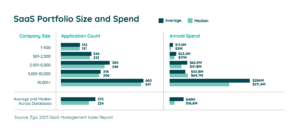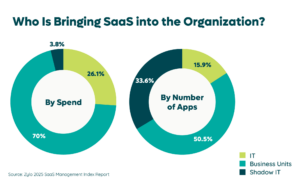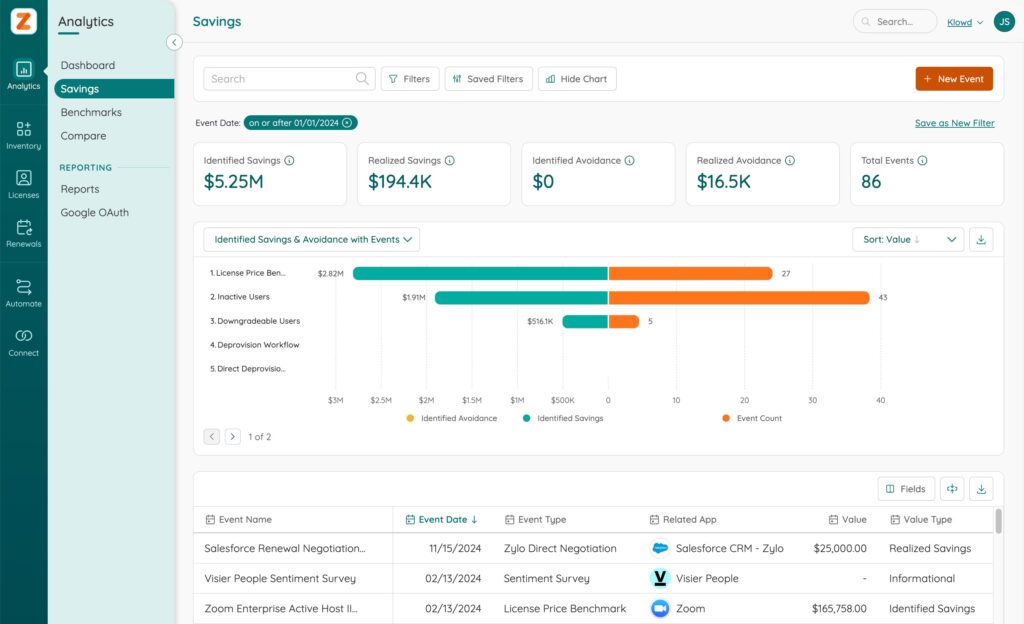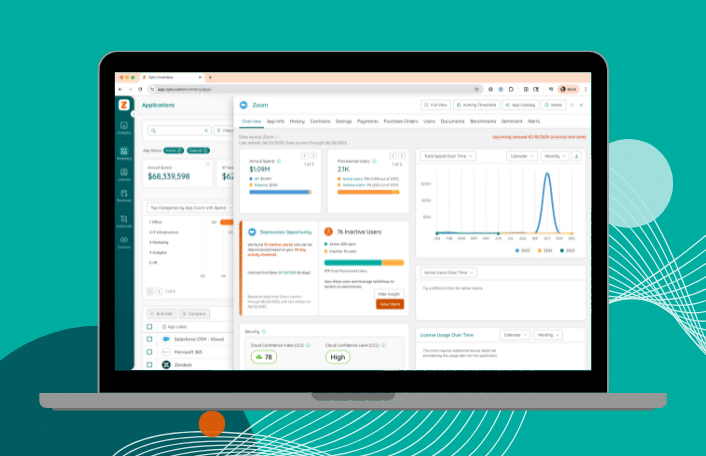
Shelfware Explained: The Hidden Cost in Your SaaS Stack
Table of Contents ToggleShelfware DefinedWhy Shelfware HappensPoor Organizational OversightShadow IT and...
Back
Back
Search for Keywords...
Blog

Table of Contents
These five goals for SaaS management ensure the proper controls are set around your SaaS investments. From elementary to advanced, once met, these goals will drive your SaaS strategy into the future.
Uncover opportunities for cost savings, better employee experience, and grow revenue through professional SaaS management.
Our first SaaS Management goal is about getting the big picture. Shadow IT carries inefficiencies, security risks, and hidden costs. With a SaaS system of record, mitigate risk, and contain costs through the discovery of SaaS applications.
Enterprises manage an average of 660 SaaS applications. Discovering these applications has proven nearly impossible. In fact, Zylo discovers three times as much SaaS spend and nearly two times as many applications as the average enterprises estimate through manual efforts.

Once the discovery of applications is complete, a SaaS system of record also contains all the relevant information necessary to determine the value of the enterprise SaaS stack.
In the age of SaaS, business units are frequently responsible for 70% or more of the overall tech spending. Therefore, to drive SaaS innovation and optimization strategies, business units must be included in reporting and decision-making processes. After all, SaaS management is a team sport.
 Regular stakeholder meetings with business leaders open lines of communication and build relationships to drive value and best practices. Collaboration can be attained through stakeholder meetings as well as software solutions.
Regular stakeholder meetings with business leaders open lines of communication and build relationships to drive value and best practices. Collaboration can be attained through stakeholder meetings as well as software solutions.
Zylo drives collaboration by assigning owners to all applications, providing views into departmental spend, and enabling sentiment surveys. In the modern enterprise, a healthy collaboration between IT and business leaders enables the sharing of time, expertise, accountability, and success.
No matter the industry, expect SaaS costs to grow within your company (growing SaaS costs means a growing company). Proper controls will help ensure that growth is as efficient as possible.
With a SaaS system of record and healthy IT collaboration, cost containment opportunities become actionable. Without Zylo, continual scrubbing of financial data is necessary to discover cost containment opportunities, such as eliminating multi-source spend. And the adoption of SaaS Management will help achieve the goal of containing costs.
With Zylo, IT leaders can identify multi-source spend, redundant applications, and underutilized applications. From these insights, IT can take action to contain costs and drive value throughout the technology stack.
Zylo’s enterprise customer success team provides continual guidance to uncover opportunities for cost savings and SaaS optimizations
Guide to Managing SaaS Costs
Learn MoreWhile SaaS applications serve a variety of functions, expectations of security, integration, and value must be met across all SaaS investments. Best practices for SaaS governance enables IT to empower business units to research, purchase, implement, and manage SaaS applications.
With Zylo-powered insights, IT can drive best practices at the source: the buyer. Without Zylo, stakeholder meetings are necessary to continue uncovering and assigning ownership to applications.
As best practices are driven at a user level, prioritize driving best practices through SaaS buyers and users in high-spend and high-risk departments. Healthy relationships built through collaboration are necessary to drive these best practices.
IT can ensure the return on investment (ROI) for SaaS is reached by determining and measuring against KPIs that feature both quantitative and qualitative components. For example, employee experience should be measured against net promoter scores as well as user surveys.
As technology becomes embedded in the business, ROI has often been measured via both IT goals and business goals. The modern IT leaders will be measuring tech investments against employee experience, customer experience, and more.

However, in many organizations, IT is still measured against hard cost savings, tool adoption success, and budgeting accuracy. Therefore, ROI measurements will include both traditional IT goals and business goals. In Zylo, utilization, sentiment, and spend metrics enable IT leaders to narrow in on ROI calculations.
If you and your team are ready to start tackling these SaaS management goals, request a demo of Zylo’s SaaS management platform today to begin understanding and optimizing your organization’s fully SaaS inventory.

Table of Contents ToggleShelfware DefinedWhy Shelfware HappensPoor Organizational OversightShadow IT and...

Table of Contents ToggleGoal 1: Establish a SaaS System of RecordGoal...

Table of Contents ToggleHow FinOps Teams Commonly Understand SaaS—and What’s MissingSaaS...

Table of Contents ToggleWhat Is an E-Commerce Tech Stack?Why Your E-commerce...
| Cookie | Duration | Description |
|---|---|---|
| cookielawinfo-checkbox-analytics | 11 months | This cookie is set by GDPR Cookie Consent plugin. The cookie is used to store the user consent for the cookies in the category "Analytics". |
| cookielawinfo-checkbox-functional | 11 months | The cookie is set by GDPR cookie consent to record the user consent for the cookies in the category "Functional". |
| cookielawinfo-checkbox-necessary | 11 months | This cookie is set by GDPR Cookie Consent plugin. The cookies is used to store the user consent for the cookies in the category "Necessary". |
| cookielawinfo-checkbox-others | 11 months | This cookie is set by GDPR Cookie Consent plugin. The cookie is used to store the user consent for the cookies in the category "Other. |
| cookielawinfo-checkbox-performance | 11 months | This cookie is set by GDPR Cookie Consent plugin. The cookie is used to store the user consent for the cookies in the category "Performance". |
| viewed_cookie_policy | 11 months | The cookie is set by the GDPR Cookie Consent plugin and is used to store whether or not user has consented to the use of cookies. It does not store any personal data. |
